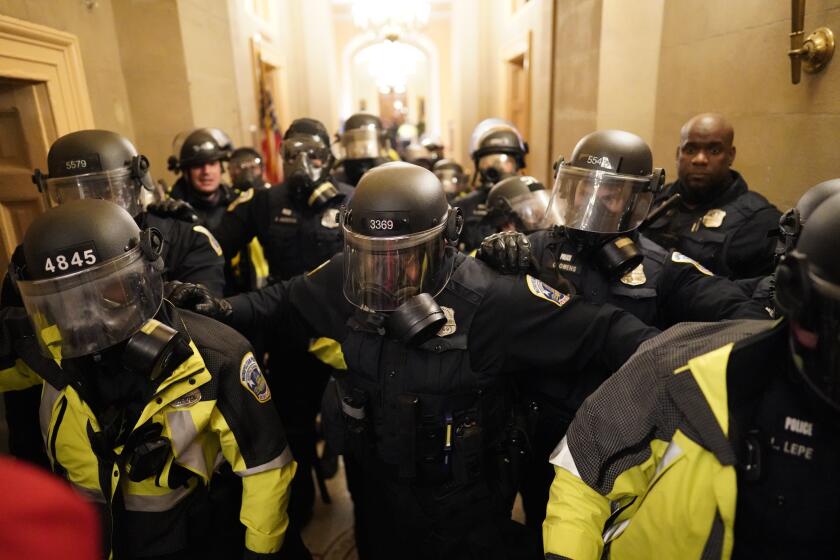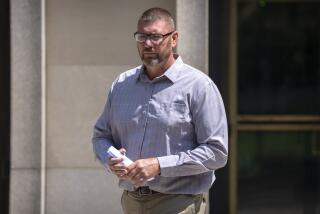The Jan. 6 assault like you’ve never seen it: from our photographer’s helmet camera

Never-before-seen footage of the chaos during the Jan. 6 attack on the U.S. Capitol, from Los Angeles Times photographer Kent Nishimura’s GoPro.
- Share via
On Jan. 6, 2021, Los Angeles Times photographer Kent Nishimura was assigned to cover a pro-Trump rally at the Ellipse, just south of the White House. Then-President Trump railed during the rally at what he falsely claimed was a stolen election and urged his supporters to march on the U.S. Capitol, where the balloting results were being certified.
Nishimura followed them, documenting the Capitol attack in real time. As he sent in photos and video of the event, he let his GoPro camera, attached to his helmet, run as long as the battery could last. That video had never been shown until now.
Discussing the events of that day, Nishimura describes how he navigated the historic moment:
You arrived at the Ellipse that morning. Did you get any sense from the atmosphere that this rally might not be a regular rally?
It was shocking, to say the least, seeing the sheer number of people assembled on the National Mall and the Ellipse. By that point, I hadn’t been in nor seen a crowd that large since the onset of the pandemic lockdowns. I had covered some protests for racial justice in Los Angeles, but the sheer size of this gathering was unlike anything I had seen.
During the Jan. 6 Capitol riot, six Congress members from California hid, fled or watched as a pro-Trump mob attacked. They look back and discuss what’s changed.
I had covered Trump rallies leading up to and during the election, yet this one felt different. The chanting, the rhetoric, the anger — all of it flowing outward from this swirling vortex of some tens of thousands of people gathered in the nation’s capital. A lot of these people were dressed in what appeared to be secondhand paramilitary gear. They were dressed for war.
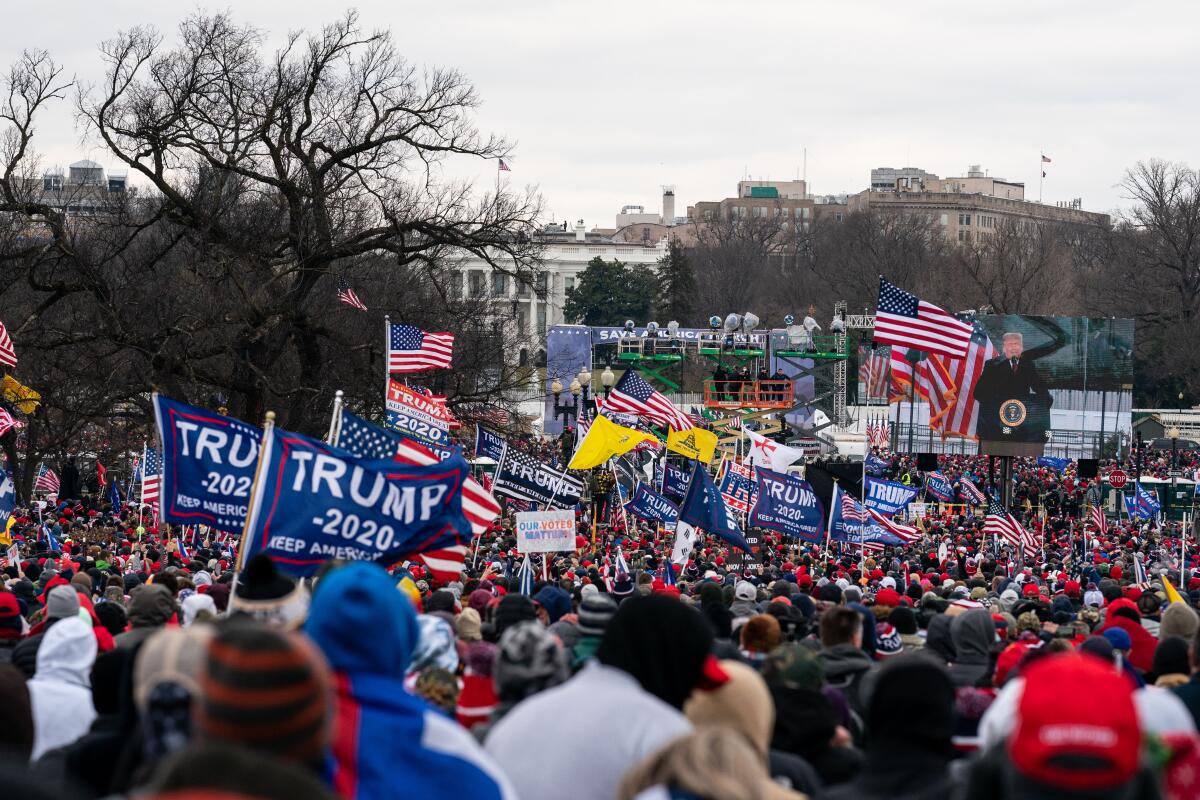
At what point did you realize things were going to get bad?
It really dawned upon me that things seemed more serious than they appeared when the mob pushed forward, going around the line of law enforcement officers, pushing onto the scaffolding where the inauguration stage was being constructed — which in a few weeks would be the site of the inauguration of Joe Biden.
Clearly, there are smoke canisters being released, pepper spray going everywhere, fights breaking out. But, you’re also in a crowd of people that doesn’t necessarily like the media. Did you ever feel in danger?
When you’re in situations like this, you’re constantly making threat assessments, making sure you have mapped out your escape route, keeping an eye on body language, proximity — determining whether there is an imminent threat and what to do to mitigate the potential for harm. As news photographers, we are tasked with documenting a situation for what it is and giving context by creating a visual record of the events unfolding in front of us. This, more often than not, requires us to be in places or situations that might potentially be precarious.
The only time I really felt like I was in danger was when a man hit me in the back of the head with a flagpole and shouted at me that I was “fake news.” Luckily I was wearing a helmet and was spared from the brunt of the attack. I had colleagues who also got attacked and weren’t as lucky.
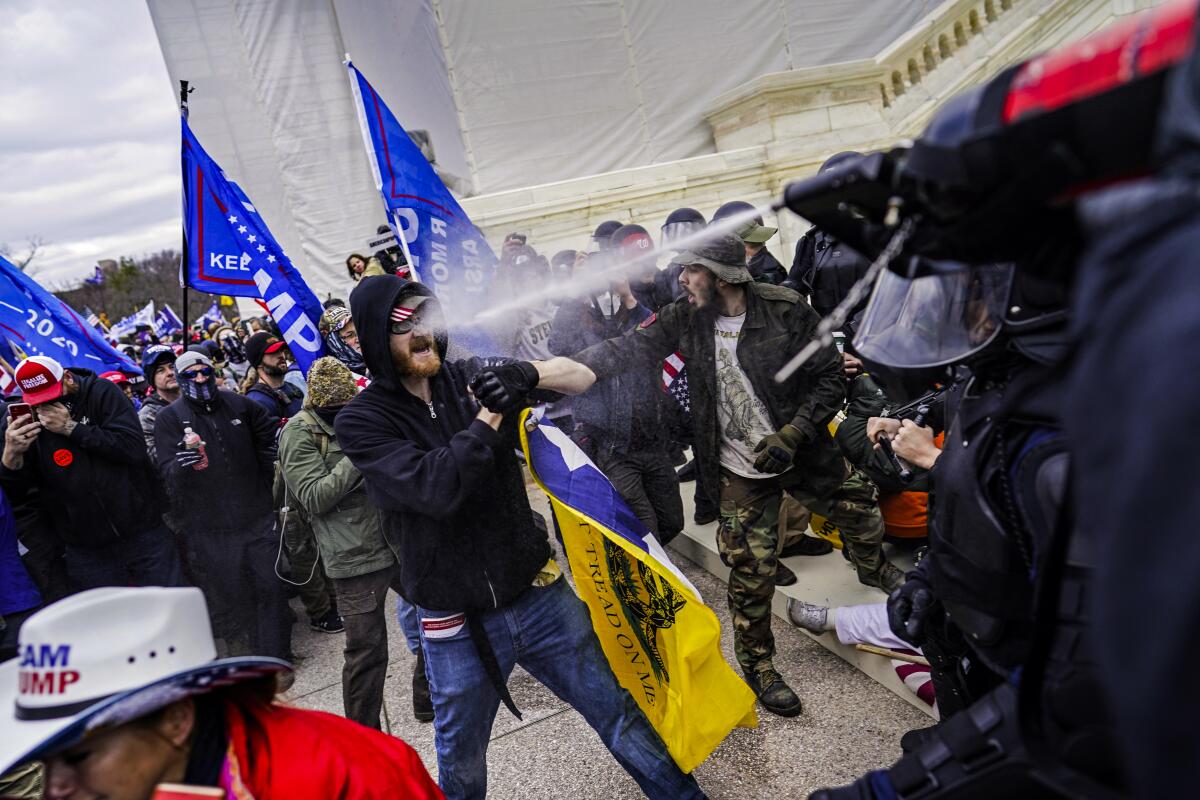
You’re feeding video and photos throughout your time there. Talk about how you do that.
The newer cameras we use have the ability to send photos directly to our smartphones or directly to FTP servers, which in turn feed directly to the office, where the images can be put on stories and posted online. As long as I had a steady cellular signal and battery power, I could send photographs back to the newsroom.
You eventually go to the other side of the Capitol and follow the crowd inside. Describe that moment.
I couldn’t believe that they were breaching the doors of the Capitol. I can still vividly remember that moment: As the Columbus Doors swung open, I was in the center of the crowd, and I felt my feet leave the ground as the insurrectionist mob started to flood in, like a tide crashing up against a seawall that had finally broken through.
I couldn’t believe what I was seeing and hearing — the sharp chirp of the building’s security alarm cut through the air, and the shouting of the word “treason” echoed into the Rotunda as the massive mob poured in through the doors. I paused in the Rotunda, thinking about the irony of the fact that the people who just breached the Capitol building in a violent, seditious manner were shouting “treason” at the top of their lungs. I was in shock.
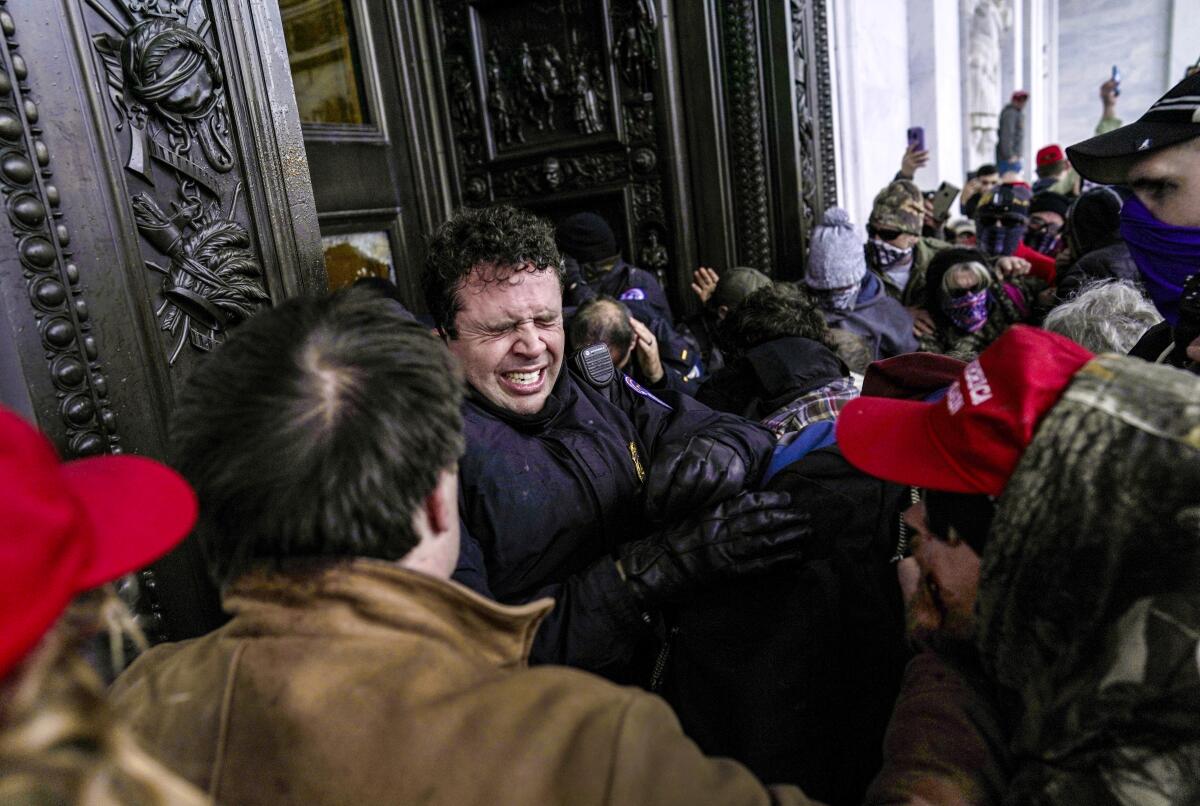
The GoPro battery dies shortly after you get inside, but that’s actually around the time you are evacuated, correct? Talk about what happened next.
I had returned to the east doors and was debating my next move. A cordon of police officers in riot gear were advancing from the Ohio Clock corridor on the Senate side, and I did not want to get caught up in the kerfuffle that would ensue once they entered the Rotunda. My GoPro’s battery had just died, and I needed to make sure I could get to a safer area to transmit images back to the office.
After a group of men shouted at me and tried to follow me, I ducked down a hallway, ran downstairs, and back upstairs near the old Senate chamber. I crossed a hallway and came out near the Mansfield Room, just outside of the Senate chamber, where I told a squad of Capitol Police officers I’d be going to the Press Photographers’ Gallery to access my laptop and recharge. They let me go up there, but soon the building would be emptied out, with remaining staff being evacuated to another area of the Capitol complex.
You get evacuated, wait for hours to get back into the Capitol, document the certification of Biden’s election, then head home — but not without one last photo. Talk about why you took the photo of the door.
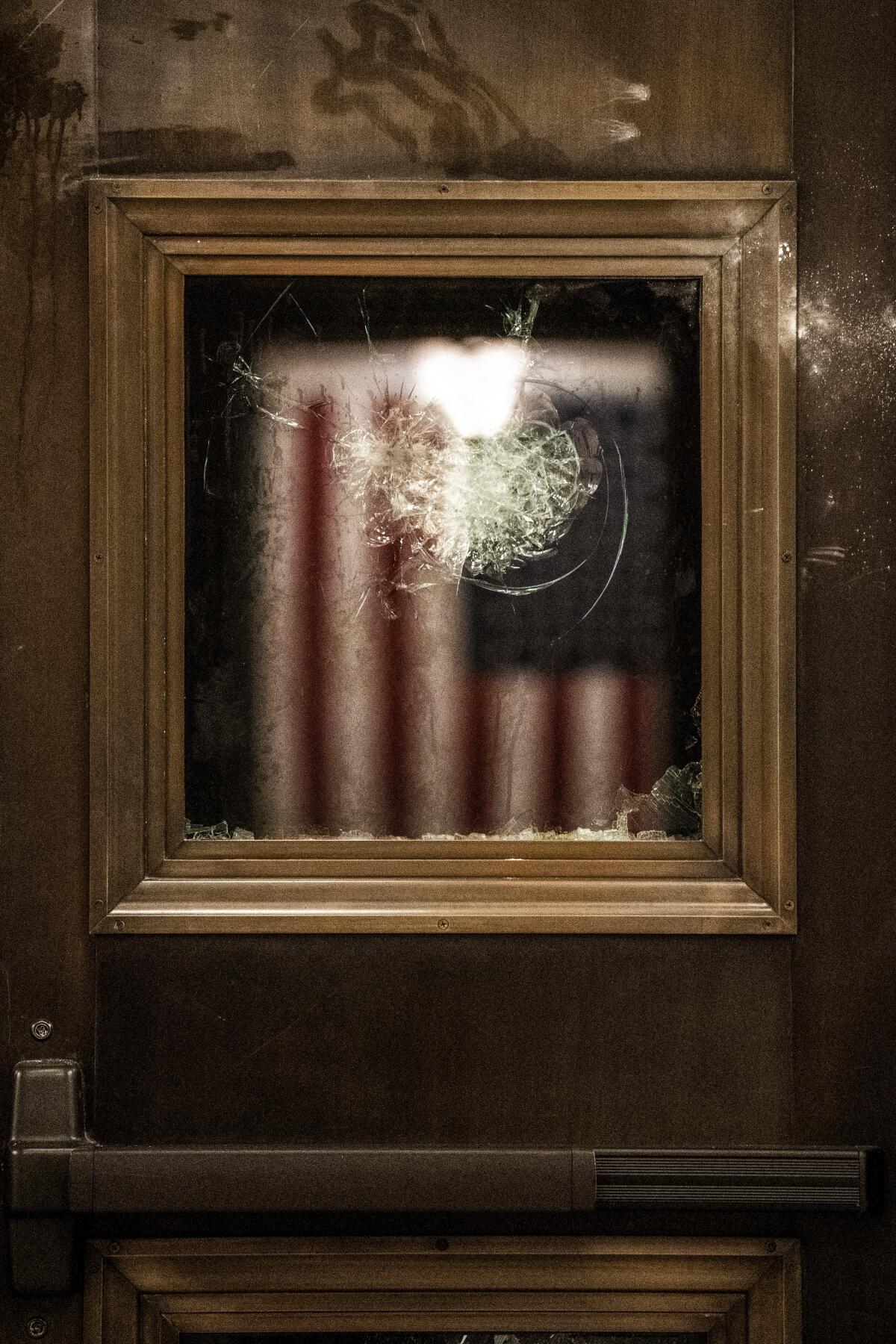
In photojournalism, there’s an adage about how a single photograph can encapsulate the story that we are seeking to tell — one image that connects with the viewer to draw them in and show the mood, the context, and convey the story’s salient details.
As I was walking through the Rotunda, I saw an American flag reflected in the cracked glass of the doors, which I had seen the insurrectionists stream through only hours prior. The flag lined up perfectly with the crack in the glass, and you could still see the residue from pepper ball projectiles — fired by law enforcement in an attempt to disperse the mob — that had burst upon impact around the door frame, with the scent of the oleoresin capsicum, or “pepper” spray, lingering in the air.
You continued covering the Capitol through the inauguration and beyond. Tell us how the atmosphere around the building changed.
Following the deadly insurrection, security became incredibly tight. Fencing went up around the Capitol and the National Mall, and the district saw a large influx of National Guard troops. The Capitol — which had been planned to embody democracy, free and open to the public at large — was now a heavily fortified fortress atop a hill, a barricaded compound, its lawns patrolled by National Guard troops.
Washington, which had started to grow more guarded after the 1995 Oklahoma City bombing and the elaborate security protocols enacted following the terrorist attacks of 2001, felt more sealed off from the public than it had in recent years — furthering the rift between the people and those that serve in the halls of power.
What is one photo you took that sticks with you and why?
On the morning of Jan. 11, I found myself on the U.S. Capitol grounds before sunrise. I had seen a large influx of National Guardsmen into D.C. and knew that they’d be posted at the Capitol. I made photographs of the troops walking past the Capitol with the iconic dome in the background, and watched as they were each issued a small breakfast box and proceeded to sit on the steps of the House of Representatives, where only a week earlier the plaza was filled with insurrectionists.
I would later come across troops quartered in the halls of the Capitol. It was such a surreal sight, to see troops quartered on the hard, unforgiving floors. Perhaps the first time this sight was beheld in more than 150 years.
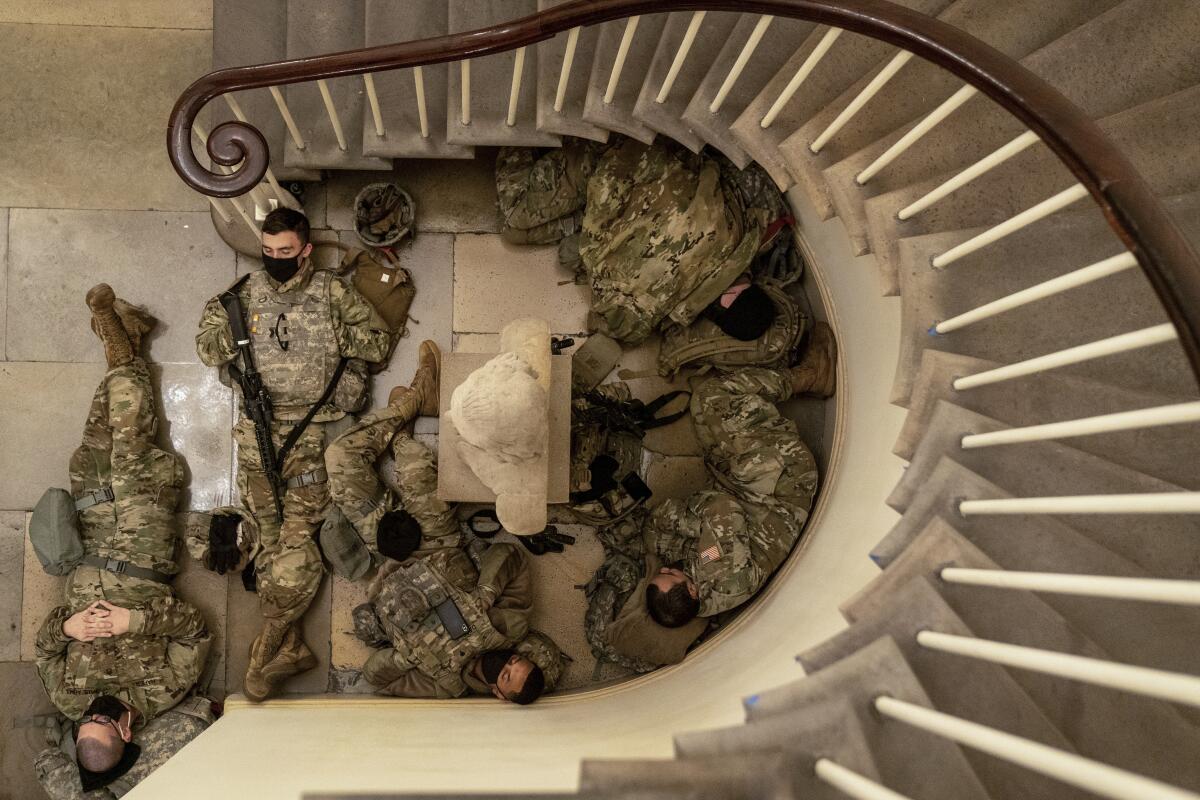
A plaque near the resting guardsmen commemorated another time when soldiers were quartered in the building: April 15, 1861, at the start of the Civil War. It was a quiet moment that I saw come together as I walked up the spiral staircase of the Small House Rotunda, the lines leading my eyes to the sleeping guardsmen: a grim yet poignant reminder of what had happened only a week earlier.
More to Read
Get the L.A. Times Politics newsletter
Deeply reported insights into legislation, politics and policy from Sacramento, Washington and beyond. In your inbox three times per week.
You may occasionally receive promotional content from the Los Angeles Times.
